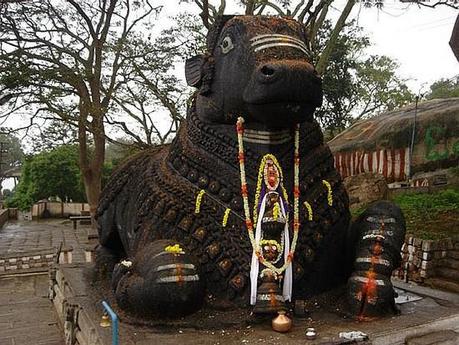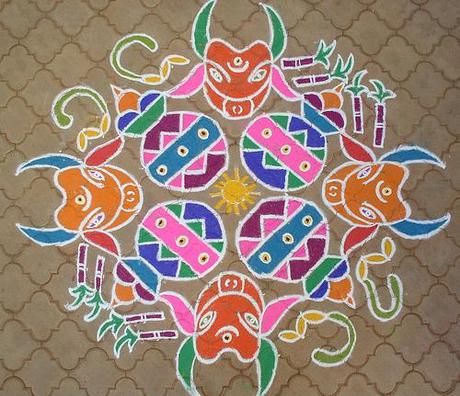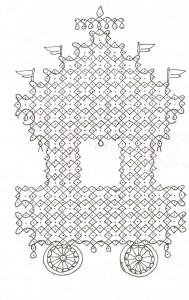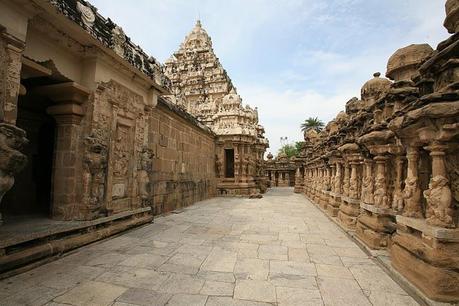This is part two of Vidya Sury’s guest post on her culture in India. (part one here) Thank you Vidya for shining some light on your customs and daily life with this post! And now, my friend Vidya:
Let me tell you some interesting random facts instead. Each of these has a story attached!
• Shiva is worshiped in the form of a lingam (phallus) in India because a Sage cursed him
• Vishnu avatars are always seen from top to toe as his feet are considered auspicious, and Vishnu is considered eye-candy
• At Vishnu temples, we offer garlands of basil (tulsi) leaves, but never for Lord Ganesha because he cursed basil
• Lord Hanuman, the monkey god is specially worshiped by bachelors for spiritual and physical strength
• We do not cut nails, hair or use a needle to stitch on Fridays as they are considered sacred to the Goddess Durga and doing this is considered inauspicious
• When we want something to happen desperately, we pray to God and offer something special as thanks when the event happens
• Women do not enter the temple or the prayer room at home during their periods.
• I recently came to know that the architectural floor plan in pharmaceutical manufacturing facilities is similar to temples and found that amazing.
• In many temples, the deities are believed to have manifested themselves divinely (not sculpted or installed by human beings)
• In Bangalore, where I live is a 500 year old “bull temple” that has the monolithic stone statue of Nandi the bull 4.5m high and 6.5m long and reputed to keep growing. Nandi is Lord Shiva’s mount. Holy Cow, eh?

Bull temple (Image credit: travel-karnataka.com)
• In one Shakti temple in South India, there is no roof as the deity is believed to keep growing.
• In most temples, after the pooja (service), it is possible to finish your meal if it is lunch or dinner time, because the “prasadam” or divine offering to the devotees is quite substantial (and yummy). Simple fare, but hot, healthy and quite filling. It is usually curd rice, tamarind rice, lemon rice and sweet rice.
• Festivals are celebrated with great gusto in temples
• We have “designs” that we draw outside our front door with rice flour. Quite a knack. There are different designs for different occasions. For marriages, there’s one. If someone is going out of town, there is a particular one to ensure they come back safely. These are symmetrical and made using dots. Just google “kolam” or “rangoli”. This one is for health and wealth:

Image credit fullfun4u.com

Chariot design (credit: itslife.in)
• Just as we leave our footwear outside the temple and wash our feet, we do the same thing when we enter our homes. We have a pair of house slippers for those who prefer not to be barefoot
There are temples that are thousands of years old and look solid, with hardly any damage in spite of being ravaged by the weather elements. Incidentally, when the Tsunami struck a few years ago, one shore temple stood solid while everything around it got damaged. The older the temple the more amazing the architecture. There are features that are mind-boggling – making you believe in magic. Many temples have been marked as world heritage buildings by the Archaeological Society of India and are well maintained. These temples are massive and just visiting them is a serious workout because of the sheer size. Here is the temple at Kanchipuram, the temple-town (the town is known for its pure silk sarees)

Image credit religiousindia.info

An aerial view of the world-famous Madurai Meenakshi Temple
So what, as I said at the beginning is my takeaway from this love for temples enhanced by my son? Here are just some of the things I’ve learned:
Prayer on a regular basis
As children, we were expected to be inside the house before 6 pm, when the evening lamp was lit. We would return home, wash our feet and head to the prayer (or pooja) room to recite a series of prayers (or slokas). We would finish at 7 and have dinner. I still follow the prayer practice, although being home by 6 pm may not always be feasible.
I begin the day by lighting the lamp at around 6 am in the morning, offering a cup of milk before we make our coffees. And dear friends, I pray for each one of you! My day begins much better for it. And guess what? My friends believe that if I pray for them for something specific, it will come true. What a compliment! As I pray, I also pledge that I will be calm, good natured and appreciative and think positive. It also creates a nice sense of routine and a feeling of accomplishment – starting the day right.
Devotion
Devotion to a higher power and dedication to what we do. A sense of commitment, especially to my prayer in the morning. My son believes that we should live our prayer – simple child logic. We pray – we promise – and we should keep it. Suits me.
Faith
As children, we grow up hearing stories of faith and belief that highlight good qualities and we try to live them. We hear about people who succeeded through their faith. So we approach everything with the belief that we will be successful and give it our best effort.
Good habits
I wake up at 5.45 am every morning, as I was taught “early to bed and early to rise makes a man healthy, wealthy and wise” Um… I cheat on the early to bed part, but I am an early riser. I find that I can accomplish far more in two hours in the morning compared to the rest of the day. Logically, this is because there are no interruptions in the form of doorbells and phone calls. See? It works, anyway.
Meditation
Spending time with ourselves, just sitting quietly, sometimes chanting “Om” This calms us, helping us approach our tasks in a cool frame of mind.
So these, dear friends, are some interesting facts about my part of the world. I hope you enjoyed reading this as much as I enjoyed writing it. Do feel welcome to ask questions!
Again, thank you, dearest Sheila!
~Vidya, thank you for being such an amazing guest. Please give my gratitude to Vidur as well for all his enthusiasm and interest in his culture.


